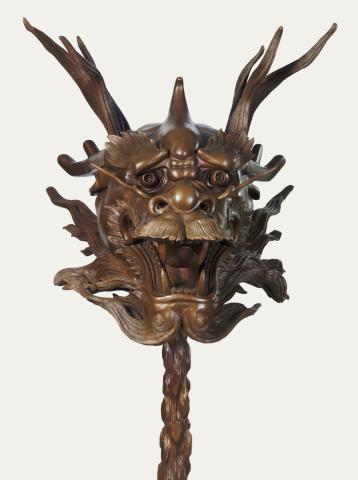
EUGENE, Ore. -- (November 28, 2017) - The “Circle of Animals/Zodiac Heads” series is internationally-acclaimed artist Ai Weiwei’s reinterpretation of the twelve bronze animal heads representing the traditional Chinese zodiac that once adorned the famed fountain-clock of the Yuanming Yuan (Old Summer Palace), an imperial retreat outside Beijing. The work will be on view in the JSMA’s North Courtyard through June 24, 2018.
“Circle of Animals/Zodiac Heads” is comprised of a dozen bronze sculptures, each roughly 10 feet
tall, that represent the signs of the Chinese zodiac: 11 real-world animals (snake, horse, ram, monkey, rooster, dog, pig, rat, ox, tiger and rabbit) and one mythical creature (dragon). Ai Weiwei created this body of work in two sizes: the bronze monumental series and the gold collector series. The “Circle of Animals/Zodiac Heads: Bronze” series is the artist's first major public sculpture project.
Designed in the eighteenth century by two European Jesuits serving in the Qing-dynasty (1644-1911) court of Emperor Qianlong (1711-1799, ruled 1735-99), the twelve zodiac animal heads originally functioned as a water clock-fountain in the magnificent European-style garden of the Old Summer Palace. In 1860, the Yuanming Yuan was ransacked by French and British troops, and the animal heads were pillaged. By recreating and re-contextualizing these objects on an oversized scale, Ai Weiwei focuses attention on issues of looting and repatriation, while extending his ongoing exploration of the “fake” and the “copy” in relation to the original, encouraging open discourse on these complex topics.
Ai Weiwei’s “Circle of Animals/Zodiac Heads: Bronze and Gold” series have been exhibited at more than forty international venues and seen by millions of people since the official launch of this body of work in New York City in 2011, making this one of the most viewed sculpture projects in the history of contemporary art.
One of China’s most prolific and provocative contemporary artists, Ai Weiwei is known for such major
projects as the installation “Fairytale” at Documenta 12 in 2007 and his collaboration with architects Herzog & de Meuron on the design for the main stadium for the 2008 Olympic Games in Beijing, as well as for his embrace of the Internet and social media as active platforms for cultural commentary and artistic practice in their own right. Throughout his career, Ai Weiwei has consistently offered insights into the relationships between art, society and individual experience through his exploration of universal topics such as culture, history, politics and tradition.
About the Jordan Schnitzer Museum of Art
The University of Oregon's Jordan Schnitzer Museum of Art is a premier Pacific Northwest museum for exhibitions and collections of historic and contemporary art. The mission of the museum is to enhance the University of Oregon’s academic mission and to further the appreciation and enjoyment of the visual arts for the general public. The JSMA features significant collections galleries devoted to art from China, Japan, Korea, Europe, and the Americas as well as changing special exhibition galleries. The JSMA is one of seven museums—and the only academic art museum-- in Oregon accredited by the American Alliance of Museums.
The Jordan Schnitzer Museum of Art is located on the University of Oregon campus at 1430 Johnson Lane. Museum hours are 11 a.m. to 8 p.m. Wednesdays, and 11 a.m. to 5 p.m. Thursdays through Sundays. Admission is $5 for adults and $3 for senior citizens. Free admission is given to ages 18 and under, JSMA members, college students with ID, and University of Oregon faculty, staff and students. For information, contact the JSMA, 541-346-3027.
Contact: Debbie Williamson Smith, 541-346-0942, debbiews@uoregon.edu
Links: Jordan Schnitzer Museum of Art, http://jsma.uoregon.edu





